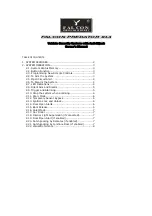
Check the house carefully in case there is a small fire
smouldering somewhere.
Check whether there is some source of smoke or fumes,
for example cooking fumes being drawn past the Smoke
Alarm by an extractor.
If there are frequent nuisance/false alarms it may be
necessary to re-locate the device away from the source
of the fumes or replace an Ionisation Alarm with an
Optical Alarm. If for some reason the Alarm continues
to sound without smoke or heat being present (due to
insect infestation or contamination build-up for example)
the units can be silenced by disconnecting the mains
power and removing the unit - see “ALARM REMOVAL”
section - page 9 (Installer section).
If cleaning the Alarm does not correct the problem
it can be returned to the manufacturer for repair or
replacement - see “Service and Guarantee” section.
Silence Feature
All the Smoke Alarms have a combined Test/Silence
Button to help you control nuisance/false alarms.
1. To silence a nuisance/false alarm, press the Test/
Silence Button located on the cover. The Alarm will
automatically switch to a reduced sensitivity condition
for a 10 minute period (very large levels of smoke
from a nearby fire will override the silence period).
The unit will flash the red light every 10 seconds (instead
of the normal 40 seconds) to indicate the sensitivity is
reduced.
On interconnected Alarms, pressing the Test/Silence
Button on the one sensing smoke (i.e. the one with the
red light flashing every second) will silence all alarms.
Pressing the Silence Button on any other Alarm will not
silence the alarm.
2. The unit will reset to normal sensitivity at the end of
the silenced period.
Use the Smoke / Heat Alarm Test Buttons to familiarise
your family with the Alarm sound and to practice fire drills
regularly with all family members. Draw up a floor plan
that will show each member at least 2 escape routes
from each room in the house.
Children tend to hide when they don’t know what to do.
Teach children how to escape, open windows, and use
roll up fire ladders and stools without adult help. Make
sure they know what to do if the alarm goes off.
1.
Check room doors for heat
or smoke. Do not open a hot
door. Use an alternate escape
route. Close doors behind you
as you leave.
2.
If smoke is heavy, crawl
out, staying close to floor.
Take short breaths, if possible,
through a wet cloth or hold
your breath. More people die
from smoke inhalation than
from flames.
5
Planning Your Escape Route
NEVER


































